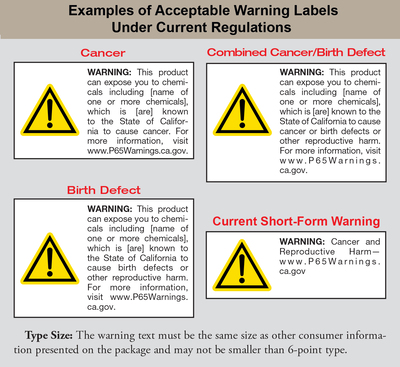By SEMA Washington, D.C., Staff
California’s Office of Environmental Health Hazard Assessment (OEHHA) proposed significant revisions to Proposition 65’s short-form warning in January 2021. The proposal was opposed by SEMA, along with dozens of other companies and organizations. Following a review of public comments, OEHHA revised the proposal in December. Although it has been scaled back, SEMA continues to oppose the proposal. Among other considerations, it would require that at least one chemical associated with cancer and/or one chemical known to be a carcinogen be identified on the short form.
The current short-form warning does not identify a specific chemical(s) while the long-form warning requires identification of a specific chemical(s):
- Short-Form: WARNING: Cancer and Reproductive Harm—www.P65Warnings.ca.gov.
- Long-Form: WARNING: This product can expose you to chemicals, including [name one or more chemicals], which is (are) known to the State of California to cause cancer or birth defects or other reproductive harm. For more information, visit www.P65Warnings.ca.gov.

Under the proposed rule, companies would now be required to list at least one chemical on the short form. Companies could only use the short-form warning if the product label was 12 sq. in. or less. OEHHA would continue to permit companies to use the short-form warning on their website or in a catalog.
SEMA has joined forces with many other organizations, including the California Chamber of Commerce, to voice opposition to the measure. SEMA and the California Chamber of Commerce has reminded OEHHA that the business community worked with the agency for several years to develop the original Prop 65 regulations that took full effect in September 2018. Companies subsequently invested significant resources in updating product labels, websites and catalogs, and instructing others in the product chain about their obligations. OEHHA’s proposed short-form warning changes would negate those efforts for many companies.
Prop 65 was a ballot initiative enacted by California voters in 1986. It requires warning labels on products containing chemicals listed as known to cause cancer, birth defects or reproductive harm. There are more than 1,100 chemicals currently on the list. Prop 65 doesn’t stop anyone from selling their products regardless of what chemicals they contain; it is simply a law that requires consumer warning labels under certain circumstances.
Prop 65 is not limited to businesses with a presence in California, but applies to all businesses with 10 or more employees that sell products in California. It impacts the entire distribution chain from manufacturers to distributors and retailers, though the law tries to put the burden as high on the distribution chain as possible—meaning manufacturers are a frequent target of enforcement.
The law permits private parties (meaning trial attorneys) to pursue enforcement and receive a portion of the fine or settlement ultimately assessed. These lawsuits, which are known as “bounty hunter” suits, are becoming more and more common, and are essentially lawyers shaking down small businesses for quick settlements.
The law requires a product warning label if the product contains a chemical that is on OEHHA’s list that is “known to cause cancer or birth defects or other reproductive harm” and the product exposes the consumer to the chemical in excess of the “safe harbor” amount of exposure. Even if the product has a significant concentration of the listed chemical (parts per million), it may create very little exposure to the consumer because the part is “under the hood” and rarely handled after installation. Aftermarket auto parts often fall into this category. There are 12 chemicals that make up a majority of Prop 65 enforcement, and aftermarket auto parts notices of violation have been focused almost entirely on DEHP and lead.
The 2018 regulation provides the short-form warning option as an acceptable alternative to the revised requirements for consumer product exposure warnings. Many companies use this option since the warning fits more easily on product packaging and in advertising materials and the company does not have to identify at least one chemical listed under Prop 65 that triggers the warning. In proposing the change, OEHHA expressed concerns about an overuse of the short-form warning label.
If OEHHA seeks to implement the rule, the agency has proposed a one-year phase in period for companies to make any necessary labeling changes.
Click here for SEMA comments.
Click here for Cal-Chamber comments.
Click here for additional Prop 65 information.
For additional information, contact Stuart Gosswein at stuartg@sema.org.





